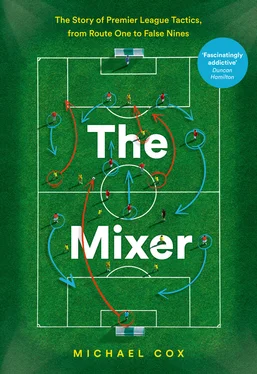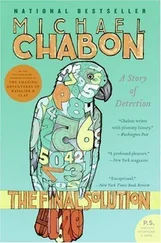The cause of Newcastle’s decline, however, was related to the addition of two signings in the New Year. Unpredictable Colombian forward Faustino Asprilla was signed on a snowy Friday in February, the day before Newcastle made the short trip to Middlesbrough. On matchday Keegan assured Asprilla he wouldn’t be playing, and at lunchtime poured him a glass of wine. But incredibly, the Colombian was introduced as a second-half substitute just hours later and created the equaliser for Watson almost immediately, bamboozling opposition centre-back Steve Vickers with a wonderful Cruyff turn before crossing. Watson pointed to Asprilla in celebration, and his teammates instinctively congratulated the assister rather than the goalscorer. Asprilla had provided Newcastle with a spark.
While his signing is sometimes blamed for Newcastle’s collapse, in the second half of the season Asprilla was Newcastle’s best player. He was fantastic in the unfortunate, and fatal, defeat to Manchester United, when the combination of Peter Schmeichel’s saves and Eric Cantona’s finish resulted in a barely deserved 1–0 win for the eventual champions. He was pivotal in the 3–0 victory over West Ham and was Newcastle’s best player in that 4–3 defeat to Liverpool, grabbing a goal and an assist. The problem, though, was that his arrival changed Newcastle’s shape entirely – and Keegan didn’t explain how he wanted his players to adjust. Asprilla was very different to Beardsley, who switched to an unfamiliar right-sided midfield role, and Ferdinand was left perplexed by the change, especially as Asprilla was immediately the main man. ‘I haven’t bought Asprilla to play with you, I’ve bought him for you to play with him,’ Keegan somewhat bluntly told Ferdinand. There were no attempts to get them on the same wavelength in training, and Keegan later told Ferdinand he simply needed to ‘expect the unexpected’ from Asprilla – a reasonable summary of his style, but hardly useful advice. Ferdinand, having been scoring at roughly a goal per game beforehand, now scored one in three.
The Colombian’s full debut coincided with Keegan’s surprise decision to switch from Newcastle’s usual 4–4–2 to a more flexible system often appearing like a 3–5–2 for a 2–0 defeat to West Ham and a hugely entertaining 3–3 draw at Manchester City. The biggest beneficiary was Albert, as the moustachioed Belgian centre-back was deployed as a sweeper with licence to burst forward. Against City he scored twice and created the other for Asprilla, all from open play, a perfect demonstration of how he was a footballing centre-back ahead of his time. Asprilla was Newcastle’s most dangerous attacking weapon in both games, but got away lightly with a one-match ban for elbowing and headbutting City centre-back Keith Curle. ‘He’s from Latin America, that’s the way they are,’ offered Keegan. That dominated the headlines, but the greater issue was that Newcastle’s lack of shape had never been more obvious. Newcastle won 43 per cent of matches with Asprilla, compared with 75 per cent without him.
For the next game, a 1–0 defeat to Manchester United, Newcastle returned to 4–4–2 but boasted another new signing: David Batty, the circumstances of whose arrival were peculiar. Sir John Hall, Newcastle’s chairman, wanted to sign a centre-back to improve Newcastle’s defence. Keegan was having none of that, however, so they compromised and bought a defensive midfielder, which doesn’t seem a particularly logical approach to recruitment. Even Batty was surprised. ‘They were flying at the top of the table and I couldn’t imagine why they’d want to change things,’ he admitted. Batty, a pure defensive midfielder, replaced the forward-thinking Clark, and once again, Newcastle attempted to play similar football with an entirely different player in a key position – the problem, of course, was the system rather than individuals. Batty slowed Newcastle’s passing and didn’t perform his defensive midfield role perfectly either – in the late-season 1–1 draw with Nottingham Forest, for example, Ian Woan dribbled past him easily before smashing into the top corner from 25 yards. Keegan considered Batty an excellent signing – although, typically, believed his long-term future was as a forward-thinking centre-back, bringing the ball forward from deep. Keegan’s logic was that this would allow him to play yet another attacking player in midfield. He simply couldn’t get enough.
Newcastle’s gung-ho approach was epitomised by that 4–3 defeat to Liverpool at Anfield in early April 1996, a game widely considered the Premier League’s greatest. It was an action-packed, end-to-end thriller, the goals starting in the 2nd minute and not ending until the 92nd. Newcastle led for the majority of the contest, both 2–1 and 3–2, but somehow conceded a late-minute winner to Stan Collymore, to leave Keegan slumped over the advertising hoardings.
Newcastle entered the game in disastrous form, having collected just seven points from their previous six matches. Keegan made one change, with Watson replacing Barton at right-back, probably linked to the fact Watson had already scored two winners that season against Liverpool, in the reverse league fixture and the League Cup.
The ludicrously open nature of the contest was summarised by the positioning of Ginola. Newcastle played a 4–4–2 system while Roy Evans’ Liverpool played 3–5–2, which meant an inevitable question about whether or not Ginola would track Liverpool’s right-wingback Jason McAteer. The answer was simple – he didn’t. This had both positive and negative consequences; after Robbie Fowler had opened the scoring and Les Ferdinand equalised, Ginola’s advanced positioning behind McAteer meant he streaked away on a counter-attack. Liverpool’s centre-backs played very narrow, and Ginola had the entire left flank to himself, finishing coolly.
In the second half, however, Liverpool exploited the space behind Ginola, in particular with Steve McManaman’s constant drifts to that flank. He crossed for Fowler to equalise and had another dangerous cross sliced just wide of the far post by Steve Howey. Newcastle raced down the other end and scored again through Asprilla, in part because Liverpool centre-back John Scales had dropped very deep to cope with Ginola’s advanced positioning, playing the Colombian onside. Liverpool soon equalised again with a right-wing cross – this time a beautiful curled ball by McAteer, with Ginola nowhere to be seen. 3–3, and arguably two goals at either end came from Ginola’s positioning. The final five minutes were even more open, after Evans boldly introduced veteran striker Ian Rush for left-wing-back Rob Jones, with Collymore moving left. After interplay between Rush and John Barnes in the centre, the ball was switched wide to Collymore, who smashed home the winner. Liverpool had won the game with the type of attacking gamble that Keegan greatly admired. Keegan loved contributing to such a legendary, attack-minded game. ‘After the match I turned to Terry Mac and said, “I know I should be disappointed, but I’m elated,”’ he later recalled.
Newcastle’s players gave various tactical explanations for their decline. Ferdinand was frustrated the attack was now built around Asprilla. Gillespie believed his omission meant Newcastle weren’t stretching the play properly, something Lee agreed with, as Beardsley wasn’t at home on the right. Goalkeeper Pavel Srníček suggested Batty upset the rhythm of the side, and also accepted that Newcastle were simply found out by better sides in the second half of the campaign. The experiment with Albert as a sweeper in a rough 3–5–2, meanwhile, lasted two games, cost Newcastle five points and was immediately abandoned. Ginola’s decline in the second half of the season was also significant; his defensive sluggishness was criticised, but it wouldn’t have been problematic had he contributed the attacking efficiency of earlier in the season.
Читать дальше












